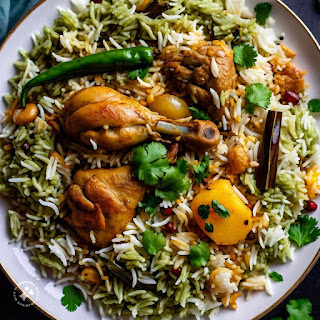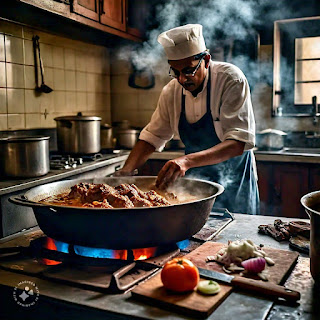Title: The Art of Biryani: A Comprehensive Guide to Crafting the Perfect Dish
 |
| chicken biryani recepie |
Introduction:
Biryani, the aromatic, flavorful, and quintessential dish of South Asian cuisine, holds a special place in the hearts and palates of millions around the world. With its origins deeply rooted in the Mughal Empire, this exquisite dish has evolved over centuries, adapting to regional tastes and culinary innovations while retaining its essence of fragrant rice, tender meat, and aromatic spices.
In his comprehensive guide, we delve into the art of biryani-making, exploring its rich history, diverse variations, essential ingredients, and step-by-step cooking instructions. Whether you're a seasoned chef or a novice in the kitchen, join us on a culinary journey as we unravel the secrets to crafting the perfect biryani.
1. Origins and Evolution of Biryani:
- Tracing the origins of biryani back to the royal kitchens of the Mughal Empire in the Indian subcontinent.
- Exploring the influence of Persian, Turkish, and Indian culinary traditions on the development of biryani.
- Discussing the regional variations of biryani across India, Pakistan, Bangladesh, and beyond, including Hyderabadi, Lucknowi, Kolkata, and Sindhi biryani.
2. Essential Ingredients:
- Rice: Choosing the right variety of rice, such as Basmati, for biryani and the importance of soaking and parboiling.Rice, a versatile staple, is a canvas for culinary creativity worldwide. From fluffy basmati in Indian biryani to sticky sushi rice in Japanese cuisine, its adaptability knows no bounds. Whether steamed, fried, or simmered in soups, rice serves as a comforting base or a star ingredient, enriching meals with its simplicity and versatility.Delicious rice, a universal staple, transcends borders with its humble yet versatile appeal. From fluffy basmati to sticky sushi grains, it forms the canvas for culinary creativity worldwide. Whether paired with savory curries or served as a comforting bowl, its simplicity belies the complex flavors it can impart to any dish.
- Meat: Selecting quality cuts of meat, including chicken, mutton, beef, or seafood, and marinating techniques for optimal flavor.Meat, a culinary cornerstone, embodies cultural heritage and sustenance. Its textures, flavors, and aromas tantalize taste buds across the globe. From succulent steaks to savory stews, meat offers versatile dining experiences. Yet, debates over ethics, health, and sustainability prompt evolving attitudes, inspiring innovative alternatives for future gastronomy.
Biryani meat, the heart of a cherished dish, melds tender protein with fragrant rice and a symphony of spices. Whether chicken, lamb, or beef, each bite unveils a rich tapestry of flavors, intricately woven in a culinary tradition spanning centuries. Biryani's allure lies in its tantalizing blend of meaty perfection.
- Aromatic Spices: Highlighting the key spices used in biryani, such as cardamom, cloves, cinnamon, bay leaves, and star anise, and their roles in enhancing the dish's aroma and taste.
Aromatic spices, nature's aromatic treasures, enliven cuisine with their vibrant flavors and fragrances. From the warmth of cinnamon to the kick of chili, they elevate dishes worldwide. These culinary gems not only tantalize the palate but also boast medicinal properties, enriching both gastronomy and health-conscious lifestyles with their ancient allsure.
- Herbs and Aromatics: I
incorporating fresh herbs like cilantro, mint, and ginger, along with fried onions and garlic, to elevate the complexity of flavors.Herbs and aromatics are culinary treasures, adding depth and complexity to dishes. From fragrant basil in Italian cuisine to vibrant lemongrass in Thai dishes, these ingredients infuse flavors and aromas. Whether fresh or dried, they elevate every bite, creating memorable culinary experiences and enhancing the art of cooking worldwide.
Herbs and aromatic spices transform biryani into a culinary masterpiece. Fragrant basmati rice, layered with marinated meat, infused with a medley of herbs like cilantro, mint, and curry leaves, creates a symphony of flavors. Each bite unveils a tantalizing blend of earthy, spicy, and fresh notes, enticing the senses.
- Saffron and Food Coloring: Exploring the use of saffron-infused milk and food coloring for layering and garnishing biryani.Saffron, prized for its vibrant color and distinct flavor, is a coveted spice in culinary arts. Its rich golden hue enhances dishes, from paella to biryani, imparting a subtle floral essence. Unlike artificial food colorings, saffron offers natural pigment, elevating both the visual appeal and taste of dishes with its luxurious touch.Saffron, nature's golden treasure, imbues dishes with a luxurious hue and delicate flavor. Used sparingly, it elevates cuisines with its distinctive aroma and subtle sweetness.
However, artificial food coloring, while visually appealing, lacks saffron's depth and authenticity, often overshadowing the nuanced tastes of dishes with its synthetic presence.Saffron, nature's golden treasure, imbues dishes with a luxurious hue and delicate flavor. Used sparingly, it elevates cuisines with its distinctive aroma and subtle sweetness.
3. Biryani Preparation Techniques:
- Dum Cooling Method: Unveiling the traditional dum cooking technique, where layers of marinated meat and partially cooked rice are sealed and slow-cooked over low heat to lock in moisture and flavors.Biryani, a flavorful rice dish, is perfected through the Dum method. After cooking, it's layered in a pot, sealed, and left to cool slowly, allowing flavors to meld deliciously.
- Pot Cooking Method: Providing an alternative method for preparing biryani in a pot or pressure cooker, suitable for those seeking a quicker cooking process without compromising on taste.Biryani pot cooking method infuses rich flavors by layering marinated meat, fragrant spices, and aromatic rice in a single vessel. Slow-cooked to perfection, steam seals in moisture, creating a delectable blend of textures and tastes, cherished in every aromatic bite.
- Vegetarian and Vegan Options: Adapting biryani recipes to cater to vegetarian and vegan diets, utilizing ingredients like tofu, paneer, mixed vegetables, and plant-based protein substitutes.Delight in the aromatic symphony of spices with our vegetarian and vegan biryani options. Savor the rich flavors of tender vegetables or indulge in the wholesome goodness of plant-based proteins, all in a fragrant bed of perfectly cooked rice.Saffron, nature's golden treasure, imbues dishes with a luxurious hue and delicate flavor. Used sparingly, it elevates cuisines with its distinctive aroma and subtle sweetness. However, artificial food coloring, while visually appealing, lacks saffron's depth and authenticity, often overshadowing the nuanced tastes of dishes with its synthetic presence.
4. Step-by-Step Cooking Instructions:
- Preparing the Marinade: Mixing yogurt, spices, herbs, and tenderizing agents like raw papaya or meat tenderizer to marinate the meat for optimal tenderness and flavor infusion.To prepare the marinade, combine oil, acid (like vinegar or citrus juice), herbs, spices, and aromatics. Adjust ratios to taste. Marinate proteins in the refrigerator for optimal flavor infusion. Consider ingredients' compatibility and marinating times for tender, flavorful results in your dish.
- Cooking the Meat: Sautéing the marinated meat until tender and succulent, enhancing its flavor profile with caramelized onions, tomatoes, and spices.Preparing meat involves meticulous seasoning, tenderizing, and marinating to enhance its flavor profile. Precise cooking methods like grilling, roasting, or braising ensure optimal texture and taste. Patience and attention to detail are essential for a mouthwatering dish.
- Parboiling the Rice: Boiling the rice until partially cooked, infusing it with aromatics like whole spices and saffron for added fragrance and color.Parboiling rice involves partially boiling it in water, then draining and drying it. This process helps remove impurities and enhances the rice's nutritional value by preserving nutrients in the grain. It also makes the rice less sticky and allows for faster cooking while maintaining its texture and flavor.
- Layering and Assembly: Assembling the biryani by layering the cooked meat and rice in a pot or dish, interspersed with fried onions, mint, and cilantro leaves, and drizzling with ghee or clarified butter.Layering and assembly are fundamental techniques in various fields, from cooking to manufacturing. Layering involves stacking components systematically, creating depth and complexity. Assembly is the meticulous process of fitting these layers together, ensuring precision and functionality. Together, they form the foundation of countless creative endeavors, from lasagnas to smartphones.
- Dum Cooking Process: Sealing the pot with a tight-fitting lid or dough to trap steam and cooking the biryani on low heat, allowing the flavors to meld together and the rice to fully cook through.Dum cooking, a traditional method in Indian cuisine, involves slow-cooking food in a sealed container over low heat. This technique allows flavors to intensify and ingredients to tenderize. Whether it's biryani, kebabs, or curries, Dum cooking ensures a rich infusion of spices and a tantalizing aroma, delighting every palate
- Garnishing and Serving: Unveiling the aromatic biryani, garnished with fried onions, chopped herbs, and lemon wedges, ready to be served alongside raita, salan, or chutney.Garnishing and serving are crucial final touches in culinary presentation. Whether it's a sprinkle of fresh herbs, a drizzle of sauce, or an artful arrangement of fruits and vegetables, garnishes elevate dishes visually and add complementary flavors. A well-presented plate enhances the dining experience, making each meal memorable and satisfying.
5. Serving and Pairing Suggestions:
- Accompaniments: Recoemending traditional side dishes like raita (yogurt dip), mirchi ka salan (spicy chili curry), or baingan ka bharta (smoked eggplant mash) to complement the biryani's flavors.
- Beverage Pairings: Suggesting beverage pairings such as lassi (yogurt-based drink), nimbu pani (lemonade), or masala chai (spiced tea) to refresh the palate and balance the richness of biryani.Beverage pairing enhances dining experiences by harmonizing flavors and textures. Whether it's wine with cheese, beer with barbecue, or tea with dessert, the right pairing can elevate both the drink and the dish. Understanding the nuances of flavors and aromas allows for delightful combinations that tantalize the palate.
}
- Dessert Options: Exploring sweet endings to the meal with classic desserts like gulab jamun, kheer (rice pudding), or rasmalai (soft cheese dumplings in saffron milk).Desserts offer a sweet conclusion to meals, ranging from decadent cakes to refreshing fruit salads. Whether indulging in classics like tiramisu or exploring exotic treats like matcha ice cream, desserts cater to diverse tastes. Their variety ensures there's always a delightful finale to satisfy every craving and occasion.
Conclusion:
Biryani, with its tantalizing blend of flavors, textures, and aromas, transcends culinary boundaries to become a beloved dish cherished by food enthusiasts worldwide. Whether enjoyed during festive gatherings, family feasts, or casual dining occasions, biryani remains a timeless culinary masterpiece that continues to captivate hearts and palates with its irresistible allure. Armed with the knowledge and techniques shared in this guide, you're well-equipped to embark on your biryani-making journey, creating memorable dining experiences for yourself and your loved ones. So, gather your ingredients, unleash your culinary creativity, and savor the magic of biryani—one delicious spoonful at a time.











0 Comments